2nd Generation Veloster Ups Its Game
Quite possibly, nay…probably, the all-new 2019 Hyundai Veloster Turbo R-Spec delivers the most performance for the dollar of any comparable car on the market. At $22,900, this 201-horsepower, six-speed manual corner-ripper is more fun, and easier on the budget, than anything else on the market. Dollars-for-smiles this just might take the cake!
The second-generation Veloster retains the “two-plus-one” asymmetrical door design from the first-generation Veloster, released in 2012. The one big door on the driver side and one big and one smaller door on the passenger side makes for a unique body style that functions quite well. Since, realistically, the Veloster will almost always only have one front seat passenger accompanying the driver, the rear seat will be folded flat, providing sufficient space necessary to haul all the luggage you need for your next road trip. Oh, and what a fun road trip it will be, as long as much of it is on corners and not endless stretches of highway.

The front-wheel drive 2018 Hyundai Veloster R-Spec is powered by a 1.6-liter turbo that produces 201 horsepower and 195 pounds-feet of torque, while running on 87 octane gasoline. The Veloster R-Spec only comes with a six-speed manual transmission. The Veloster 2.0-liter model has an optional six-speed automatic, while the 1.6-liter Turbo and Turbo Ultimate can be had with a seven-speed dual clutch automatic, with paddle shifters. Confusing? Not really, it just depends on your driving style and what level of interior accouterments are desired.
Before getting into the performance of this fun compact hatchback, let’s talk fuel economy. The EPA rating on our Veloster R-Spec 6 M/T was 26 city/33 highway/29 combined. In 383 miles of driving throughout Southern California–mostly on highways–Clean Fleet Report averaged 34.5 mpg. But in a 101-mile all-highway drive with the cruise control set at 65 mph, we achieved a very respectable 40.1 mpg.
The beauty of a small displacement engine is the potential of high fuel mileage numbers. But if you spend most of your time in city rush hour freeway traffic, the manual transmission and the constant spooling of the turbocharger will make your drive more spirited, but leads to sipping more gasoline. So if your driving pattern is the stuck-in-traffic type, as opposed to finding a twisty and curvy road, then go with the 2.0-liter non-turbo and the automatic transmission.
Fuel economy numbers reported by Clean Fleet Report are non-scientific and represent the reviewer’s driving experience. If you live in cold weather, high in the mountains, spend time in the city or stuck in rush hour traffic, then your numbers may differ.
Driving Experience: On the Road
Zero-to-sixty in about seven seconds is respectable. The engine is smooth without a sense of any turbo lag. Hyundai says the peak torque is at 4,500 rpm, but we were impressed with the 2nd-3rd-4th sequence from a low torque range of 1,550 rpm to the 4,500-rpm mark. There was no torque steer or wheel spinning when coming off the line, as the power got to the tires efficiently. Get the car out on the freeway at 65 mph, downshift from 6th-to-4th, and the tach jacks to 4,500 rpm—and pulls and pulls and pulls. The 1.6L turbo wasn’t too happy approaching the 6,750-rpm red line, so shifting before then will maximize performance.
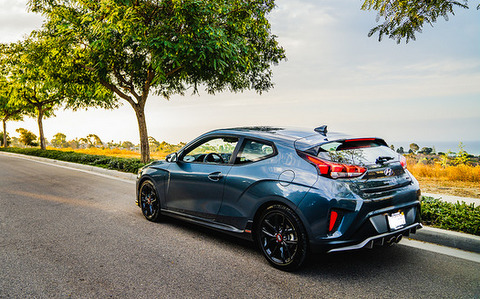
Clean Fleet Report’s favorite manual transmission comes on the Mazda MX-5 Miata, but the Veloster R-Spec manual isn’t far behind, and is an improvement from when we last tested the Veloster Turbo in 2017. Note: Hyundai skipped the 2018 Veloster model, taking time to get the redesign right.
The six-speed manual has short, precise throws, as well as a clutch with a minimal learning curve and excellent feel. In town driving we experienced no engine lugging and, pounding the transmission during aggressive acceleration, we never suffered a missed or grinding gear. With the engine’s low-end torque, it means there is less shifting when driving around town or stuck in rush hour traffic. Second goes almost to zero, while it can be wound-out well over 40 mph.
The rear suspension has been changed, with a noticeable difference. In our review of the 2017 Veloster Turbo, we noticed the Southern California concrete-grooved freeway pavement caused harshness and choppiness. New for 2018, the Veloster R-Spec has a multi-link rear suspension that replaced the previous torsion beam design. The bottom line is far more stability, with most of the jarring from road imperfections eliminated, resulting in a more controlled drive.
With a spry curb weight of 2,921 lbs., the steering has also improved from the past generation, especially when putting the car into Sport mode. Hyundai likes adjustable steering; in Sport mode, the steering gets stiffer and far more responsive than when in the default normal driving mode. Therefore, except when on the open highway, I kept the R-Spec in Sport at all times. Contributing to the sprightly handling were the torque vectoring control, standard 18-inch alloy wheels and 225/40-R18 Michelin Pilot Sport 4 summer tires. The more cars Clean Fleet Report tests with the grippy Pilot Sport 4 tires, as opposed to all-season tires, the more we like them.
The Veloster R-Spec sits low to the ground, lending itself to tight cornering and quick maneuvers. Body roll, or the feeling of leaning when pushing the limits on higher speed corners, was minimal. However, a couple of times we did feel the car wanting to step-out when the corner went from banked to flat.
Technology also was a part of the ride and handling with electronic stability control and vehicle stability management. Stopping comes from front and rear vented front discs and solid rear brakes, with ABS and brake assist.
Pouncing Stance
The distinctive Veloster R-Spec has a very recognizable look and profile, with a stance that leans forward as if ready to pounce. Painted in an attractive Thunder Gray, with black wheels that fill the wells and minimum chrome, Clean Fleet Report’s R-Spec got its share of eye balls. The Veloster redesign is a winner, especially since it looks like a coupe, but the extra door on the passenger side (with a hidden handle) provides functionality and flexibility that a small two door hatch can’t deliver. The door placement is a safety factor for rear seat passengers, as they enter from curbside and not in the flow of traffic.
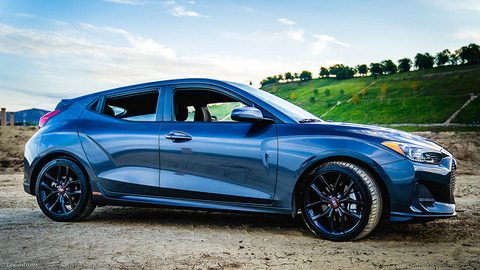
Hyundai says the 2019 Veloster offers a compelling “expressive design” that will appeal to the “young-at-heart and auto enthusiasts.” I think they are right on both points. The stubby nose features a large, three-dimensional grill with active air shutters for improved aerodynamics.
LED headlights and low, wide-set fog lights, lead to a gently sloped hood and a laid-back windshield. The meeting point of the windshield and roof is the high point on the car, with the roof then precipitously sloping to the integrated spoiler, set high above the small rear hatch window. The large LED taillights and the twin chrome exhaust tips are focal points of the rear. Hyundai calls the stance “more muscular” making a “powerful gesture.”
Driver-Focused Interior
Hyundai lets the driver have some fun with an active engine sound system. The three modes–minimized, normal and enhanced–pump engine sound through the speakers. The throaty note in the enhanced mode was pleasant when hitting the twisties, but switching to normal or minimized when in the city is a nice option for quieter cruising.
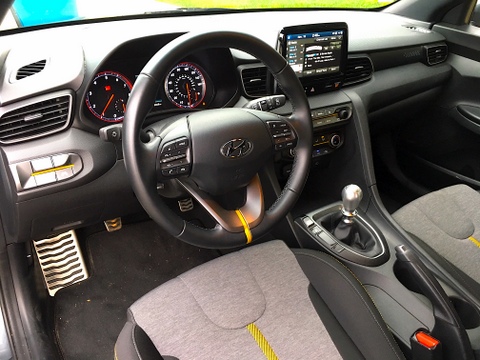
Clean Fleet Report’s 2019 Veloster R-Spec came with no options and was nicely configured for comfort and safety. Standard with the R-Spec is the eight-speaker Infinity premium audio system with subwoofer and amplifier. An 8.0-inch color, high-resolution touchscreen display gave life to the voice-command navigation and the rear back-up camera. Bluetooth for hands-free telephone and audio operations were controlled from the multi-function (cruise control, radio and telephone), leather-wrapped steering wheel. Entertainment options include SiriusXM/FM/CD/AMHD with MP3 playback capability. Also included were smartphone apps for Android Auto and Apple CarPlay, plus USB connectivity, 115V outlet and AUX jacks.
The cockpit design is driver-friendly with the gauges in easy sight and the controls handy to reach. The side and rear sight lines are compromised by small windows and large seats/headrests, but the standard lane keep assist and the driver side blind sport mirror were used on every lane change.
R-Spec unique cloth seats in black and grey with a yellow center stripe are of a sport design with wraparound wings that help hold you in place while ripping corners. All adjustments are manual and do not include lumbar. Other nice interior touches are a metal shift knob, alloy clutch, brake and acceleration pedals, and bins and cubbies for plenty of small item storage.
While the front seat offers very good head and legroom, the rear seating area is a completely different story. Unless you are transporting children, then the best use of the 60/40 folding backseat is to lay it flat and take full advantage of the expanded storage space.
Pricing and Safety

The 2019 Hyundai Veloster comes in eight models or trim levels with base prices ranging from $18,500 to $26,900. Clean Fleet Report’s Veloster R-Spec had an MSRP of $22,900. All prices do not include the $885 freight charge.
Hyundai has equipped the Veloster with active and passive safety features including four air bags, a tire pressure monitoring system, driver’s blind spot mirror, and a forward collision-avoidance system.
The 2019 Hyundai Veloster has not been rated yet by the NHTSA, but the 2017 model received an Overall 5-Star National Highway Transportation Safety Association (NHTSA) rating.
Warranties
The 2019 Hyundai Veloster comes with these warranties:
- Powertrain 10 years/100,000 miles
- New vehicle Five years/60,000 miles
- Roadside Assistance Five years/Unlimited miles
- Anti Perforation Seven years/Unlimited miles
Observations: 2019 Hyundai Veloster Turbo R-Spec
Many high school graduates take a Gap Year before heading off to college, during which time they usually travel, taking in the sights and cultures of far-off lands. Hyundai also took a Gap Year in 2018, but they did something far more significant: they redesigned the Veloster into a markedly more impressive car than the last model.
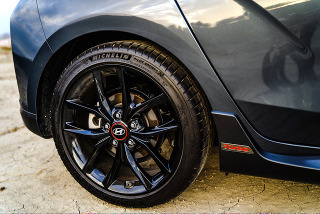
The 2019 Veloster is offered in four models: 2.0, R-Spec, Turbo and N. Within these four there are trim packages and optional equipment to choose from. The Veloster R-Spec nudges into the hot hatch category, but at a lower entry price than the high performance Veloster N.
If you have read this far then it is obvious you are not a crossover or SUV fan. If you believe that a car must be fun to drive, then you must give the Veloster Turbo R-Spec a spirited test drive, and see for yourself, because experiencing is believing.
Whatever you buy, Happy Driving!
Photos By Lex Adams
Related Stories You Might Enjoy—Sporty Options
Road Test: 2018 Mazda MX-5 Miata Club
Road Test: 2017 Mazda MX-5 RF
Road Test: 2018 Toyota 86 GT Black
Road Test: 2018 Volkswagen Golf R
Road Test: 2018 Lexus LC500
Road Test: 2018 Lexus LC 500h
Road Test: 2016 Scion FR-S
Road Test: 2015 Fiat 500C Abarth
Disclosure:
Clean Fleet Report is loaned free test vehicles from automakers to evaluate, typically for a week at a time. Our road tests are based on this one-week drive of a new vehicle. Because of this we don’t address issues such as long-term reliability or total cost of ownership. In addition, we are often invited to manufacturer events highlighting new vehicles or technology. As part of these events we may be offered free transportation, lodging or meals. We do our best to present our unvarnished evaluations of vehicles and news irrespective of these inducements.
Our focus is on vehicles that offer the best fuel economy in their class, which leads us to emphasize electric cars, plug-in hybrids, hybrids and diesels. We also feature those efficient gas-powered vehicles that are among the top mpg vehicles in their class. In addition, we aim to offer reviews and news on advanced technology and the alternative fuel vehicle market. We welcome any feedback from vehicle owners and are dedicated to providing a forum for alternative viewpoints. Please let us know your views at publisher@cleanfleetreport.com.


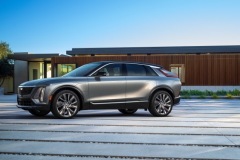
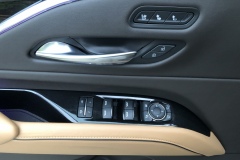
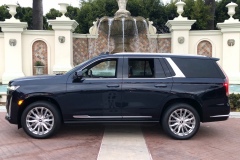
10 thoughts on “Road Test: 2019 Hyundai Veloster Turbo R-Spec”